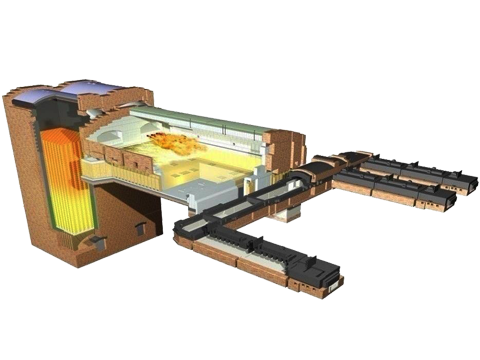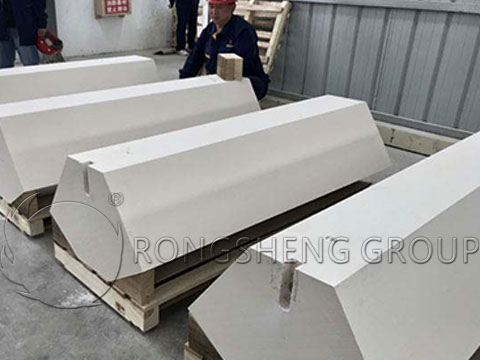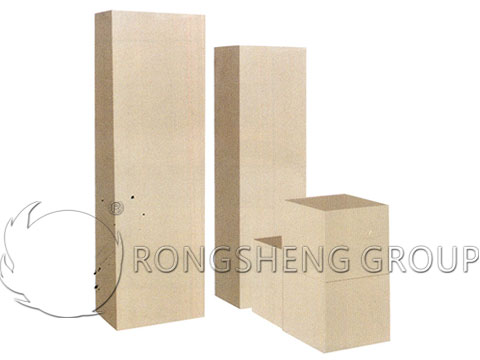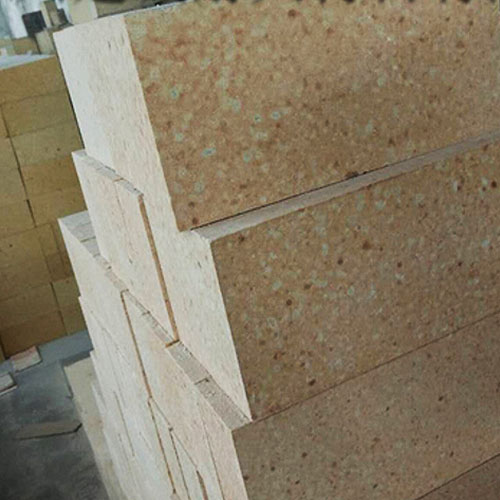
Fused Refractory Bricks for Glass Furnace
The fused refractory is made by melting the precisely prepared mixture in an electric arc furnace, and then pouring it into a sand mold. The ingot is subjected to mechanical processing after heat treatment. The smelting process can obtain complete coarse crystals and dense structure. Compared with sintered refractories, it has the characteristics of compact structure, low porosity, high volume density, high mechanical strength and high temperature structure strength, and strong resistance to glass liquid corrosion. At present, the main types of refractory linings used in glass kilns are fused mullite bricks, fused zirconia corundum bricks, fused chromium zirconium corundum bricks, fused quartz bricks, fused corundum bricks, and so on.

Mullite bricks are refractory products of aluminum-silicon system with mullite as the main crystal phase. The refractory temperature is about 1850℃, the load softening temperature is high, the high temperature creep rate is low, and the thermal shock resistance is good.
Fused mullite bricks are made of high-alumina bauxite, and different bauxites are made into mullite composition (3Al2O3·2SiO2, with mass fractions of Al2O3 72% and SiO2 28%). It melts at around 2300℃, is poured into a sand mould at 1850℃, and then annealed to relieve stress. The main crystal phases are mullite and corundum, and the glass phase is filled between the crystal phases. Its corrosion resistance to molten glass is stronger than that of sintered refractories, but not as good as other fused refractories. Adding a small amount (7%~8.5%) of zirconium dioxide can make the mullite crystal smaller and the brick structure dense. The amount of mullite is increased to 60%~70%, which relatively reduces the content of the glass phase and reduces the cracks of the product. Fused mullite bricks have been basically replaced by fused zirconium bricks.
Fused zirconium corundum brick belongs to Al2O3-ZrO2-SiO2 system (abbreviated as AZS brick). According to the content of ZrO2, it is divided into three levels. The corresponding grades are AZS-33 (containing ZrO2 33%), AZS~36 (containing ZrO2 36%), AZS-41 (containing ZrO2 41%).
Fused zirconium corundum bricks are made of zircon and industrial alumina as the main raw materials, and a small amount of zircon-rich sand (in order to increase the content of ZrO2), soda ash and borax are added.
According to the different atmosphere during melting, there are two types: reduction melting method and oxidative melting method. At present, it is mainly based on oxidation method. The oxidation melting method can remove the pollution caused by the graphite electrode in the molten liquid, and the carbon content is low (0.005%~0.02%), which can reduce the bubble rate in the glass and improve the quality of the glass liquid.

The matters needing attention when using fused zirconia corundum bricks are as follows.
Fused corundum bricks are made by using high-purity alumina as raw material, introducing a small amount of soda ash, and melting them at 2000~2200℃. The production process is similar to that of high-aluminum products. There are fused α-corundum bricks, fused α, β-corundum bricks, and fused β-corundum bricks. Fused α-corundum bricks are mainly suitable for melting borosilicate glass, opal glass and sulfate-containing melts. The composition of fused α, β-corundum bricks contains only a small amount of glass phase, which will not ooze out during use, and has little pollution to the glass liquid. Direct contact with molten glass will not cause the molten glass to be colored, and has good corrosion resistance. It is an ideal material for the wall of the cooling part of the glass melting furnace, the bottom of the furnace, and the flow trough of the float glass melting furnace. Fused corundum bricks are suitable for the upper structure of the working pool of the melting furnace and the combustion port at the rear of the melting zone and the breast wall and small furnace flat screed near it.

Introduce 10%~30% Cr2O3 into AZS-33 bricks, and produce fused chromium-zirconium corundum bricks (abbreviated as AZCS bricks, and the French brand name is ER2161.) by the non-shrinkage pouring method. Both the surface and the inside of the brick are dark green. The brick contains 4.5% shrinkage cavities and no connected pores. Due to the formation of the aluminum chromium spinel solid solution, the viscosity of the glass phase is increased, and the corrosion resistance of the glass liquid is greatly improved. It is 3.4 times of fused AZS-33 brick and 2.6 times of fused AZS-41 brick.
The production process of fused quartz brick is the same as that of quartz glass. Using high-purity quartz sand (with SiO2 content above 99.5%) as raw material, adding a small amount of Na2O as a mineralizer, and melting it in a graphite resistance furnace (1750~1800°C). After melting, the whole piece of molten material is quickly taken out, rolled into bricks, and then machined after cooling in the air. The coefficient of thermal expansion is extremely small, and the thermal shock resistance is good. It has strong corrosion resistance to boron glass liquid, but it is not resistant to the erosion of soda lime silica glass liquid.
The main component of zircon products is ZrO2·SiO2. Zircon decomposes into ZrO2 and SiO2 when heated at 1680℃. The liquid glass of zircon products has good corrosion resistance. Aluminum-Zirconium-Silicon (AZS) fused-cast bricks and fired bricks have good corrosion resistance to molten glass, and can be used for the wall and upper structure of glass melting furnaces.

Zircon bricks are refractory products fired with zircon as the main raw material. Zircon is the only compound in the ZrO2-SiO2 system, and its chemical formula is ZrSiO4. The theoretical chemical composition of zircon is 67.2% ZrO2 and 32.8% SiO2. Zircon bricks have excellent properties such as high temperature resistance, good thermal vibration resistance and resistance to glass liquid corrosion.
To purchase high-quality refractory brick lining materials for glass kilns, please choose a strong refractory material manufacturer. Not only is the price cheap, but also has a wealth of customer service experience. It is guaranteed in product quality and after-sales service. To learn more about refractory materials for glass kilns, please continue to pay attention to our website. If you need us to provide more detailed product specifications of refractory bricks, please contact us by email. We will provide you with the most suitable service according to your specific needs.

Glass Kiln Furnace Lining
1. Fused Mullite Brick
Mullite bricks are refractory products of aluminum-silicon system with mullite as the main crystal phase. The refractory temperature is about 1850℃, the load softening temperature is high, the high temperature creep rate is low, and the thermal shock resistance is good.
Fused mullite bricks are made of high-alumina bauxite, and different bauxites are made into mullite composition (3Al2O3·2SiO2, with mass fractions of Al2O3 72% and SiO2 28%). It melts at around 2300℃, is poured into a sand mould at 1850℃, and then annealed to relieve stress. The main crystal phases are mullite and corundum, and the glass phase is filled between the crystal phases. Its corrosion resistance to molten glass is stronger than that of sintered refractories, but not as good as other fused refractories. Adding a small amount (7%~8.5%) of zirconium dioxide can make the mullite crystal smaller and the brick structure dense. The amount of mullite is increased to 60%~70%, which relatively reduces the content of the glass phase and reduces the cracks of the product. Fused mullite bricks have been basically replaced by fused zirconium bricks.
2. Fused Zirconia Corundum Brick
Fused zirconium corundum brick belongs to Al2O3-ZrO2-SiO2 system (abbreviated as AZS brick). According to the content of ZrO2, it is divided into three levels. The corresponding grades are AZS-33 (containing ZrO2 33%), AZS~36 (containing ZrO2 36%), AZS-41 (containing ZrO2 41%).
Fused zirconium corundum bricks are made of zircon and industrial alumina as the main raw materials, and a small amount of zircon-rich sand (in order to increase the content of ZrO2), soda ash and borax are added.
According to the different atmosphere during melting, there are two types: reduction melting method and oxidative melting method. At present, it is mainly based on oxidation method. The oxidation melting method can remove the pollution caused by the graphite electrode in the molten liquid, and the carbon content is low (0.005%~0.02%), which can reduce the bubble rate in the glass and improve the quality of the glass liquid.

Fused Zirconia Corundum Brick
The matters needing attention when using fused zirconia corundum bricks are as follows.
① Irregular changes in thermal expansion.
Fused zirconia corundum bricks are characterized by stable and dense structure, and strong resistance to molten glass. Bricks containing 31%~33% ZrO2 have abnormal expansion at 900~1200℃.
②Electrical insulation.
Fused zirconia corundum bricks have good electrical insulation and decrease with the increase of temperature. Electro-fused zirconium corundum bricks can be used as electrode bricks in the production of soda-lime glass furnaces.
③ Thermal conductivity.
The thermal conductivity of fused zirconia corundum bricks is twice that of clay bricks. Therefore, when making pool wall tiles, the cooling air volume required near the liquid level should be twice as large as when clay bricks are used as pool walls.
Fused zirconia corundum bricks are characterized by stable and dense structure, and strong resistance to molten glass. Bricks containing 31%~33% ZrO2 have abnormal expansion at 900~1200℃.
②Electrical insulation.
Fused zirconia corundum bricks have good electrical insulation and decrease with the increase of temperature. Electro-fused zirconium corundum bricks can be used as electrode bricks in the production of soda-lime glass furnaces.
③ Thermal conductivity.
The thermal conductivity of fused zirconia corundum bricks is twice that of clay bricks. Therefore, when making pool wall tiles, the cooling air volume required near the liquid level should be twice as large as when clay bricks are used as pool walls.
3. Fused Corundum Brick
Fused corundum bricks are made by using high-purity alumina as raw material, introducing a small amount of soda ash, and melting them at 2000~2200℃. The production process is similar to that of high-aluminum products. There are fused α-corundum bricks, fused α, β-corundum bricks, and fused β-corundum bricks. Fused α-corundum bricks are mainly suitable for melting borosilicate glass, opal glass and sulfate-containing melts. The composition of fused α, β-corundum bricks contains only a small amount of glass phase, which will not ooze out during use, and has little pollution to the glass liquid. Direct contact with molten glass will not cause the molten glass to be colored, and has good corrosion resistance. It is an ideal material for the wall of the cooling part of the glass melting furnace, the bottom of the furnace, and the flow trough of the float glass melting furnace. Fused corundum bricks are suitable for the upper structure of the working pool of the melting furnace and the combustion port at the rear of the melting zone and the breast wall and small furnace flat screed near it.

Fused Corundum Brick
4. Fused Chrome Zirconia Corundum Brick
Introduce 10%~30% Cr2O3 into AZS-33 bricks, and produce fused chromium-zirconium corundum bricks (abbreviated as AZCS bricks, and the French brand name is ER2161.) by the non-shrinkage pouring method. Both the surface and the inside of the brick are dark green. The brick contains 4.5% shrinkage cavities and no connected pores. Due to the formation of the aluminum chromium spinel solid solution, the viscosity of the glass phase is increased, and the corrosion resistance of the glass liquid is greatly improved. It is 3.4 times of fused AZS-33 brick and 2.6 times of fused AZS-41 brick.
5. Fused Quartz Brick
The production process of fused quartz brick is the same as that of quartz glass. Using high-purity quartz sand (with SiO2 content above 99.5%) as raw material, adding a small amount of Na2O as a mineralizer, and melting it in a graphite resistance furnace (1750~1800°C). After melting, the whole piece of molten material is quickly taken out, rolled into bricks, and then machined after cooling in the air. The coefficient of thermal expansion is extremely small, and the thermal shock resistance is good. It has strong corrosion resistance to boron glass liquid, but it is not resistant to the erosion of soda lime silica glass liquid.
6. Zircon Brick
The main component of zircon products is ZrO2·SiO2. Zircon decomposes into ZrO2 and SiO2 when heated at 1680℃. The liquid glass of zircon products has good corrosion resistance. Aluminum-Zirconium-Silicon (AZS) fused-cast bricks and fired bricks have good corrosion resistance to molten glass, and can be used for the wall and upper structure of glass melting furnaces.

Zirconia Brick
Zircon bricks are refractory products fired with zircon as the main raw material. Zircon is the only compound in the ZrO2-SiO2 system, and its chemical formula is ZrSiO4. The theoretical chemical composition of zircon is 67.2% ZrO2 and 32.8% SiO2. Zircon bricks have excellent properties such as high temperature resistance, good thermal vibration resistance and resistance to glass liquid corrosion.
To purchase high-quality refractory brick lining materials for glass kilns, please choose a strong refractory material manufacturer. Not only is the price cheap, but also has a wealth of customer service experience. It is guaranteed in product quality and after-sales service. To learn more about refractory materials for glass kilns, please continue to pay attention to our website. If you need us to provide more detailed product specifications of refractory bricks, please contact us by email. We will provide you with the most suitable service according to your specific needs.
Tags: Fused, Refractory, Bricks,
- Prev: Preparation of Zircon Brick with More than 65% Zr2O3 Content
- Next: Refractory Bricks for Cement Kiln Transition Zone
Inquiry
If you want to learn more about our Refractory Products, please feel free to fill the inquiry form below.
We will get in touch with you ASAP!
Copyright @ Zengzhou Rongsheng Kiln Refractory Co., Ltd. All Rights Reserved | Site Map | ExportBureau profile


